Research Article - (2020) Volume 9, Issue 8
Delicious Sea buckthorn Hippophae rahmnoides belongs to the family Elaeagnaceae. It’s wildly grown in Gilgit-Baltistan and Chitral, China, being the largest producer of sea buckthorn contributes 90% of the total global production. It is indigenous to Europe and some northern regions of Asia. The world’s second-largest sea buckthorn resources are the Himalayan region of India. There is no record found of Sea buckthorn production in Pakistan. The study conducted in Yarkhoon valley revealed that it has the least contribution to the economy. Study shows that 67.9% of sea buckthorn grows mostly in a wild area, 51% in the gravel area and 39% prefer to grow in a semi-arid area. Almost 71% of water resources of sea buck thorn-covered by man. According to 89.7% of the population, the maximum age of sea buckthorn is twenty. Berries are used for asthma, control blood pressure, diabetes, anti-aging, hepatitis, and paralysis. The decrease in flooding caused by rain 78%, snowmelt 84.4%, glacier 84.4%, flash 90.8%, GLOF 85.3%, and avalanches 76.1%. The change in wildlife was 92.6% and only 7.3% observed no changes. Hierarchical clustering analysis revealed that there is great diversity across varieties. Based on the color of berries of sea buckthorn in Mastuj there are five varieties including orange code 024A, red code 033A, yellow code 012A, orange-red code 033B, and yellow-orange code 015A based on RHS coloring.
Sea buckthorn • Dendrogram • Elaeagnaceae • Chitral • Paralysis • Hierarchal.
Sea buckthorn is widely distributed throughout the temperate zone of Asia and Europe [1]. In 1923 Sea-buckthorn was introduced into North America [2]. Sea buckthorn is a common name for a group of shrubs or small trees belonging to the genus Hippophae Linn of the Elaeagnaceae family [3]. All species of the genus Hippophae are dioecious, thorny, and willow-like woody plants [4]. Sea buckthorn plant was given to the horses to help them gain weight and thus a shiny coat appears because of weight gaining, which led to the name Hippophae, hippo meaning HORSE and pharos meaning SHINNING [5]. Sea buckthorn is indigenous to Europe and some northern regions of Asia, as it is widely distributed in the temperate regions of Asia [6]. Sea buckthorn is wildly grown in many areas of Gilgit- Baltistan and Chitral and due to lack of awareness regarding its economic, medicinal and nutritional value; the plant is used for the fencing and fuel only [7]. Sea buckthorn has antioxidant property and contains many bioactive compounds such as organic compounds, amino acids, flavonoids, vitamin A, C, E [8]. Sea buckthorn is cultivated in Mongolia and the global market is exported under the name of the Mongolian sea buckthorn brand [9]. It is believed that the world’s second-largest sea buckthorn resources are the Himalayan region of India [10]. In 1977 ministry of public of Chinese listed it as official pharmacopeia. It relieves cough and helps indigestion. It has also beneficial effects on eyes, skin, and sugar metabolism [11]. It is used to cure duodenal and gastric ulcers, diarrhea, hypertension, anemia, and gout. The bioactive compounds present in the fruit help in enhance vision, delay aging, and increase immunity [12]. Sea buckthorn has few pests and diseases. These diseases are fusariosis, verticilliumalbo, and verticillium wilt. These diseases are caused by fungus Fusariumspp, Alternaria species pythium, and botrytis [13].
The study was aimed to investigate the genetic diversity among the Sea Buckthorn varieties grown in the Yarkhoon Valley District Chitral, and its role in the livelihood of the rural communities. Sea Buckthorn has never been investigated for its commitment at the family unit level in the territory. This study will help the concerned agribusiness division, ranchers, and scientists to expand on the outcomes to change Sea Buckthorn into all the more adding to rancher’s family unit economy.
Study area
This planned research is field-based and will be based on the collection of primary data from the particular research area. i.e Yarkoon Valley Tehsil Mastuj District Upper Chitral (Table 1).
| S.No | Villages | Latitude:N |
|---|---|---|
| 1 | Shoust | 36◦45′26.2″ |
| 2 | Zhupo | 36◦36′03.17″ |
| 3 | Bang | 36◦31′25.70″ |
| 4 | Brep | 36◦25′25.16″ |
| 5 | Mragram | 36◦31′22.06″ |
| 6 | Chapali | 36◦20′13.18″ |
| 7 | Chuinj | 36◦18′54.73″ |
| 8 | Chinar | 36◦17′53.55″ |
Table 1: Table of elevation of height villages.
Study area and sampling
Plant samples (male and female plants) were collected from particular eight villages including Shoust, Zhupo, Meragram, Bang, Brep, Chuinj, Kargin, and Chinar of Tehsil Mastuj District Upper Chitral and the data for surveys will be collected from Tehsil Mastuj through focused random sample technique. To collect Ethnobotanical data on Sea buckthorn sample sizes are haggard from the cited sample structure.
Sample frame
Survey study ranges to eight villages of the Yarkhoon valley including Shoust, Zhupo, Meragram, Bang, Brep, Chuinj, Kargin, and Chinar of Tehsil Mastuj households will be surveyed as a unit. There are a total of 169,240 households.
Sample size
The sample size is the no of projected responses from the survey units i.e. HH from each village in Tehsil Mastuj Using the following formulae; Sample size (paste image from survey monkey) Total No of HH/population (N, Margin Error in % which is 5 in this case (5%), confidence level 95% and z-score which is 1.96 in this case (z) (paste image from survey monkey) Using the above formulae, a total No of 120 HH will be surveyed.
Survey parameters
There are three major types of parameters that will be deal with within the entire research module; Morphological parameters, Ecological Features and Socio-economic.
Morphological parameters: These parameters include measurements of leaves (Lamina Size (width, length), Seed (Size, weight, and number), Berry (color, fresh weight, dry weight, and number), DBH of the stem, canopy cover of plant and Plant height (both female and male plant).
Ecological features: Ecological features are water conservation, Soil conservation, and fertility enhancement.
Socio-economic survey: This survey includes Income sources, Ethno botanical uses and Ethno-ecological uses.
Data collection/tool: Taxonomic material and Ethno botanical data of Sea buckthorn.
Data processing and analysis
Qualitative and Quantitative data collected will be analyzed using descriptive and inferential statistical analytic tools including ANOVA, Regression analysis, etc.
Measurement of the berries, leaves, height, DBH, and canopy cover
For weighting, the berries in fresh and dried state electronic balance will be used. While for drying the berries oven (write the model) will be used where the berries are put into cotton placed Petri dishes and dry at 48-degree centigrade for 3 to four days, whereas for measuring the leaves a scale is used for measuring of height, DBH and canopy cover measuring tape is used.
Climate change perception survey
Parameters (ecological): Water conservation, soil conservation (soil erosion) and fertility enhancement.
Data collection/tool
Data processing and analysis: Qualitative and Quantitative data collected will be analyzed using descriptive and inferential statistical analytic tools including ANOVA, Regression analysis etc.
Plant material and sampling method
Sea buckthorn species at first will be identified and then the samples (berries and leaves) were collected randomly from three parts including starting point, midpoint and endpoint of eight villages Shoust, Zhupo, Meragram, Bang, Brep, Chuinj, Kargin and Chinar of Tehsil Mastuj. Ten plants are in ratio (male to a female) are selected from each three-point from all eight villages. So in this way thirty plants are selected from each village respectively. Twelve leaves are collected from each plant, labeled in small plastics bags. The specimen of (100) berries will be collected and labeled in small size zipper plastic bags. Berries would be then measured for their size, color, fresh weight, dry weight and its seed’s weight while the leaves will be measured for their length and width of the lamina. Berries colors are identified through the RHS color scheme.
Socio-economic survey
A questionnaire is developed to collect a social sample of the research area to know about the major income sources of the inhabitants, Ethno botanical and Ethno ecological uses of Sea buckthorn in their lives. The survey is conducted in all the areas where the plant sample is collected.
Sterilization of materials
All the washable equipment’s used in the lab while separation, counting and drying the berries and measuring the leaves, they will be washed properly with detergent and rinsed with water to avoid any kind of contamination. Furthermore, the glassware’s will be sterilized utilizing autoclave.
Gender
Study shows that 26.6% population was female and 73.4% were men. And the maximum age ratio within the population was 28.5%.
Education
It was observed that 28.4% of the populations were illiterate. 28.4% were under primary, 22.9% secondary, 3.7% high secondary,11% graduate and 5.5% of the study population was masters. Income profile of surveyed area shows that 70% income source were employment 34% the source was agriculture followed by 23% were businessmen and another source like labor.
Sea buckthorn profile
According to interviewee 67.9%of sea buckthorn grows mostly in wild area 2.8% grows in cultivated area and 29.4% grows in both wild and cultivated area.
Soil type profile
The soil profile in the study area shoes that 51.4% sea buckthorn is grown in gravel soil followed by 30.3% grown in sandy soil, 0.9% in loamy soil, 5.5% in gravel soil and11% infertile soil respectively (Figure 1).
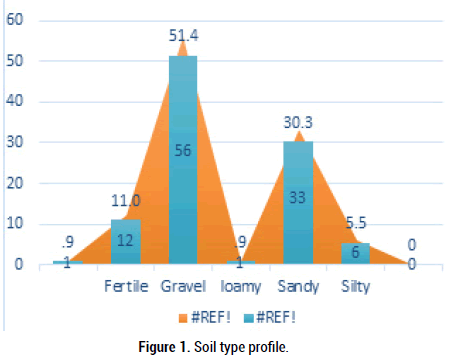
Figure 1: Soil type profile.
Area type profile of sea buckthorn
The study revealed that the total 39.4% sea buckthorn prefers to grow in a semi-dried area, 19.3% in dried, 22.9% in sunny and 17.4% in moist area respectively.
Plants growth preference profile
The survey report reveals that according to most people juniper, Artemisia, trees grasses, Populous, and deodar plants are preferred to grow near the sea buckthorn population. Wild rose and papsak are also growing near the sea buckthorn population. In the study area 71% of water resources of sea buck thorn-covered by man, 11% are rainwater and 16.5% population agreed that both options are the source of water.
Age profile of sea buckthorn
The survey report reveals that according to 89.7% population the maximum age of sea buckthorn is twenty and 9.3% says the maximum age is forty (Figure 2).
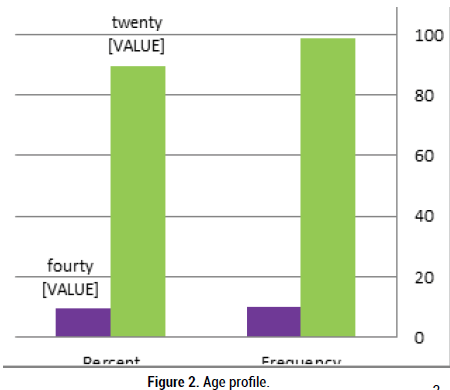
Figure 2: Age profile.
Leaves used profile of sea buckthorn
According to the survey 60% of people have not used leaves for any purpose. However, 32% of people used leaves as animal fodder, and 5% of people used leaves as animal food. Leaves were used for tea, weight loss, and control blood pressure by only 1% respectively. The survey reveals that all frame size 100% used stem as wood in dry condition. Study shows that the majority of the population in the surveyed area used berries in fresh form for many diseases. Berries are used for asthma, stomach, control blood pressure, and diabetes by most of the people. Other people used berries as a lotion for fairness and anti-aging. Some are used berries for hepatitis, cough, hen food, and paralysis.
Climate change perspective
This research reveals that seasonal rainfall intensity and frequency have decreased over the last decade 2007-2017 some people experienced a decreased in rain frequency during spring 69.7%, winter 68.8%, autumn 67.0%, summer 71.6%. Some people believed that rainfall has an increase in spring 2.8%, winter 2.8%, autumn 7.3%, and summer 9.2%. However, according to some people there is no change in the rain in spring 17.4%, winter 19.3%, autumn 16.5%, and summer 9.2%.
Wind
The study shows that 67% of wind frequency has a decrease in spring, 63.3% both in autumn and summer respectively. Only 24.8% experienced no change in rainfall. The study reveals that the highest decrease in snowfall in spring and winter is 66.1%.
Temperature
TStudy shows that temperature is increased in all seasons during the last decade continuously. It shows that 97.3% of temperature increase in spring, 99% in autumn, 97.3% in winter, and 94.6% in summer. According to 0.9% of people, there is no change in the temperature in all seasons. Highly increased temperature is observed by 2.8% in summer and 0.9 in winter. Research shows that the decrease in frequency and intensity of flooding caused by rain 78%, snowmelt 4.4%, glacier 84.4%, flash 90.8%, GLOF 85.3%, and avalanches 76.1%. Similarly, some people observed highly decrease in flooding due to rain and GLOF is the same as 0.9% and avalanches 2.8%.
Village cover
The survey shows that 66% of the village cover is increased 22.9% says it’s highly increased,2.8% says no changes occurred and 8.3% says the village cover is decreased (Figure 3).
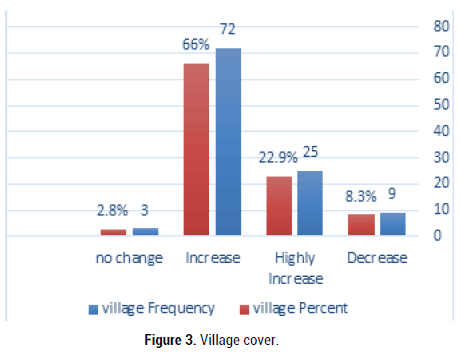
Figure 3: Village cover.
Disease
The research revealed that diseases are decreasing on plants 34.9%, livestock 41.3%, and wildlife 41.3% respectively. Most of the people experienced that diseases are increased on plants 45.8%, livestock 43.1%, and wildlife 43.1%. However, some people observed no change in diseases on plants 20.2%, livestock 5.6%, and wildlife 15.6% (Figure 4).
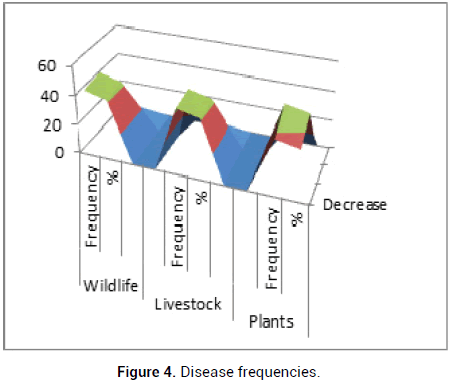
Figure 4: Disease frequencies.
Crop sowing, harvesting, fruit-bearing and annual yield period
Research shows that the decrees in the crop sowing period are 36.7%, annual yield period 41.3%, crop harvesting period 37.6%, and fruit-bearing period 32.1%. The study area shows that the decrease in crop sowing period is 34%, annual yield 29.3% crop harvesting period 32.1%, fruitbearing period 35.8%. Similarly, many people observed no change in the fruit-bearing period 32.1%, crop harvesting period 30.1%, annual yield period 29.4%, and crop sowing period 28.4%.
Change in wood consumption, glacier size, and forest cover
The study reveals that the decrease in fuel consumption is 62.4%, in glacier size 60.6%, and 56.9% in forest cover respectively. Minimum respondents have observed an increase in fuel wood consumption 13.8%, glacier size 15.6% and in forest cover 16.5%. Likewise, the change in consuming fuel wood was observed by 23.9%, glacier size 22.9%, and change in forest cover 26.6%. Only 0.9% of respondent don’t knows about wood consumption and change in glacier size.
Pasture cover
The study revealed that 66.1% of pasture Cover is decreased, according to 16.5% it is increased and 7.3% said no changes occurred and 10.1% observed highly decreased (Figure 5).
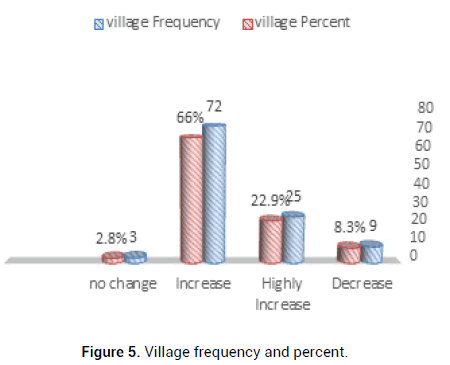
Figure 5: Village frequency and percent.
Information about wildlife
The population who observed the change in wildlife was 92.6% and only 7.3% observed no changes.
The current study was conducted to discover the different varieties, genetic diversity, and the role of sea buckthorn in the livelihood of Yakhoon Valley Tehsil Mastuj. The purposes of the study were to assess the genetic diversity of different sea buckthorn verities found across Tehsil Mastuj and to discover the role of sea buckthorn in the livelihood and its diversification in the study area. The study provides basic tackles for students during research. Sea buckthorn is a thorny shrub with soft small yellow leaves to dark orange berries [14].
The current study somehow correlated with koskovac study that sea buckthorn has soft small leaves. Our findings agree with Suhvhqwhg et al. study that varieties among sea buckthorn species are due to the quantity of water and barriers size of sea buckthorn [15]. Opposing to the studies of different researchers including Surya Kumar and Gupta ,Zielinska and Nowak, Krejkarova et al., Rafalsk et al. that different parts of diphosphateramnoides used as medicine in different parts of the world [16-19]. Parts such as berries are used for different diseases including diabetes, hepatitis, stomach, asthma, skin, cough, control blood pressure, and paralysis in the study area Tehsil Mstuj. Krejcarova et al. describe the positive effect of sea buckthorn on animal and human health [18]. The research also reveals that leaves are used for animal fodder and control blood pressure. The result was in agreement with Mangla and Tendon that sea buckthorn plants are separated into a male and female plant. The results also supported with Rajchal findings that sea buckthorn is thorny plant grow in gravels, moist, semi-dried area, and used as food and medicine [20]. The presentstudy result correlated with Momani Shaker that sea buckthorn berries are used hen food [21]. Opposing to the studies of scientist Shah et al. sea buckthorn has diverse ecotypes and the varieties of due to diverse ecosystems [22]. Hierarchical clustering analysis revealed that there is great diversity across varieties. Based on the color of berries of sea buckthorn in Mastuj there are five varieties including orange (code 024A), red (code 033A), yellow (code 012A), orange-red (code 033B), yellow-orange (code 015A) on the basis of RHS coloring.
The study has shown that there is great diversity across varieties in Tehsil Mastuj based on the color of berries of sea buckthorn. These verities are five including orange code 024A, red code 033A, yellow code 012A, and orange-red code 033B, yellow-orange code 015A based on RHS coloring. This research suggests that a complete assessment chain development programmed can establish on the promotion of its value-added products its role in livelihood and diversification.
I would like to dedicate this research paper to my beloved colleague Tehmina for her generous support and prayers.
Author declares that there is no conflict of interest.
Citation: Sadiq Ali and Tehmina. Morphological and Livelihood Profiling of Hipophae rhamnoides from Yarkhoon Valley Chitral Pakistan: A Climate Change Perspective. J Biol Today's World, 2020, 9(8), 001-004.
Received: 15-Jul-2020 Published: 07-Aug-2020, DOI: 10.35248/2322-3308.20.9.004
Copyright: 2020 Ali S, et al. This is an open-access article distributed under the terms of the Creative Commons Attribution License, which permits unrestricted use, distribution, and reproduction in any medium, provided the original author and source are credited.